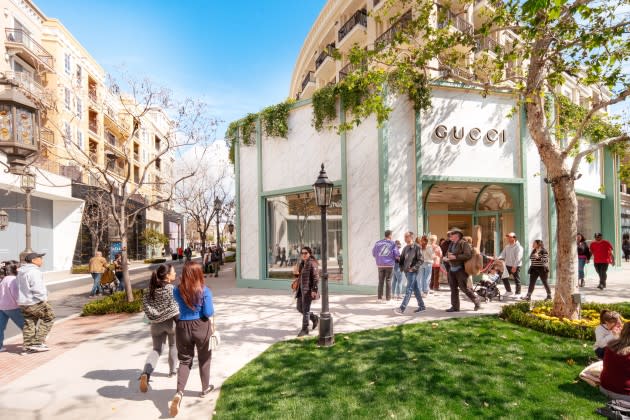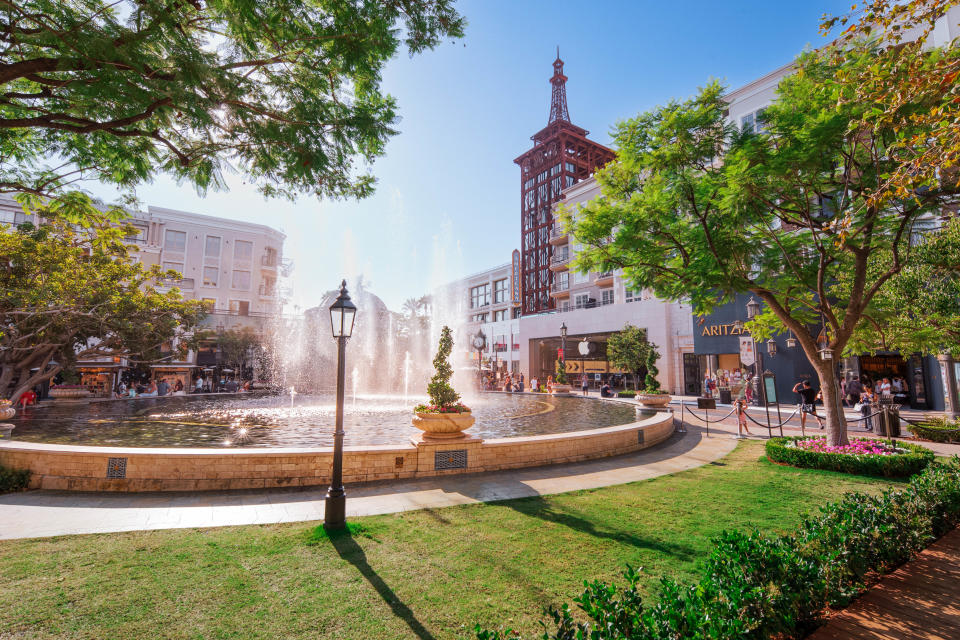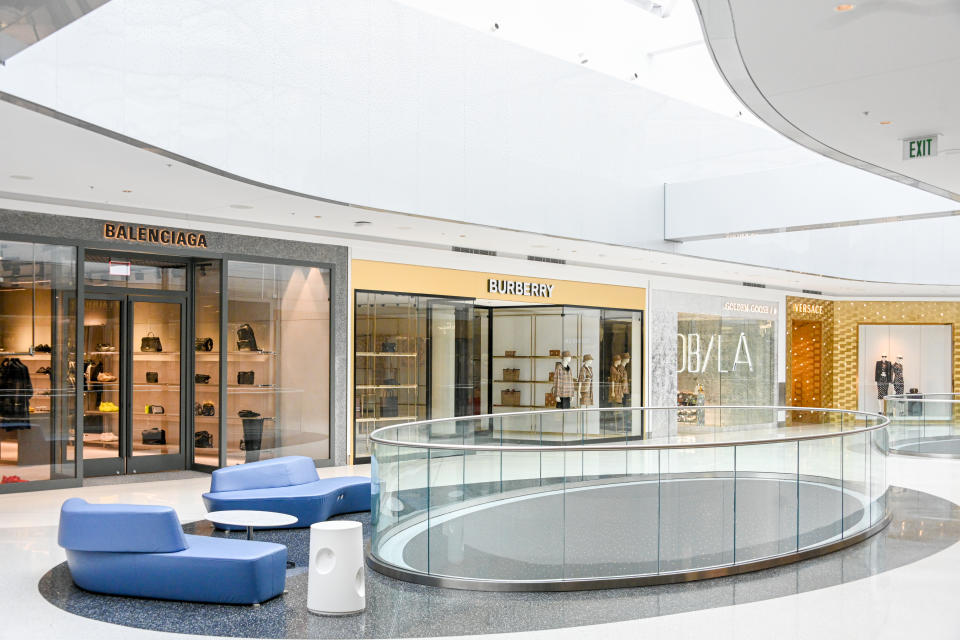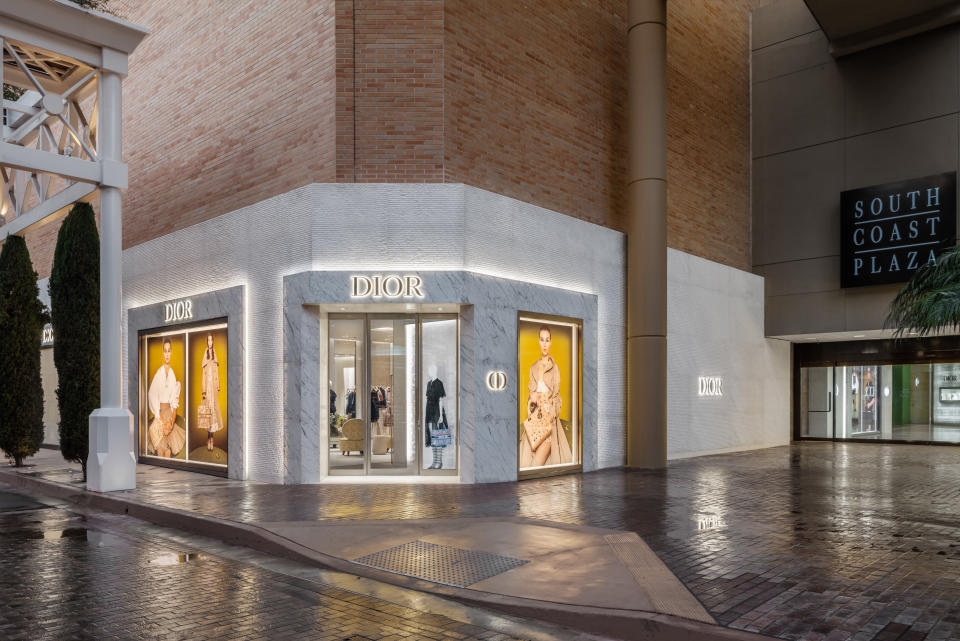Luxury Stores See New Opportunities in Southern California’s Top Shopping Centers
- Oops!Something went wrong.Please try again later.

The Americana at Brand, an upscale outdoor shopping center with an electric trolley running through it and splashy fountains that rise and fall to various tunes, has always catered to an affluent customer who doesn’t mind dropping $300 for athletic shoes or $400 for a leather handbag.
These days, however, shoppers at the Los Angeles area location are finding more opportunities to go upscale. In the last few months, the 15-year-old shopping destination, owned by Caruso, formerly known as Caruso Affiliated, has added a handful of luxury stores that include Saint Laurent, Gucci, Golden Goose and soon-to-be expanded David Yurman and Tiffany & Co. stores that remind us that diamonds can be our best friend.
More from WWD
The new luxury outposts join a retail lineup that already includes Nordstrom, Chanel Beauty & Fragrance and Apple. Soon to arrive will be luxury beauty store Byredo, Omega and, next year, Bottega Veneta.

“There has been a ton of interest from luxury retailers,” said Jackie Levy, chief financial and revenue officer for Caruso, founded by billionaire Rick Caruso, who last year ran for Los Angeles mayor and lost to Karen Bass. Levy noted the Americana has four more leases signed with luxury brands, whose identity will be revealed later.
“We are 100 percent leased and trying to figure out spaces for some of the other great retailers that want to be here,” Levy added.
Currently, 13.6 percent of the 81 stores at the Americana at Brand fall into the luxury category, and that soon will number just under 20 percent. At Palisades Village, a Caruso retail property near the ocean in L.A.’s wealthy Pacific Palisades neighborhood, luxury has grown to 25 percent of the retail mix, with the recent addition of Bottega Veneta and soon Saint Laurent.
Since the pandemic, luxury brands have been launching new stores as a self-defense mechanism. In the past, high-end department stores such as Saks Fifth Avenue, Neiman Marcus and Nordstrom were attracting consumers searching for top-dollar items not found elsewhere. But those large-scale retailers are still suffering from the pandemic’s economic whammy and not attracting customers as before.
“The old model of shopping centers relied on department store anchors to draw in business and then specialty stores would pick up the traffic,” said Jerry Storch, a longtime retail executive who once was the chief executive officer of Hudson’s Bay Co. and is now the CEO of Storch Advisors. “That doesn’t work now because the anchors are not that healthy. It has been tough on Nordstrom and Macy’s.”
Nordstrom has been slowly inching its way back from a major economic downfall in fiscal 2020 when it had a net loss of $690 million on $10.3 billion in sales. Last year, it pulled in an annual net profit of $245 million on $15 billion in revenues. Despite the profit improvement, it recently announced it is closing all 13 of its Nordstrom and Nordstrom Rack stores in Canada because they are unprofitable. It will soon close two stores in San Francisco — a Nordstrom Rack and a Nordstrom.
Macy’s, a mid-tier retailer that carries luxury items in some of its outposts, has been challenged with more of its consumers affected by inflation or turning to other e-commerce sites and shopping venues. The large department store chain, founded in 1858, is expecting a 1 percent to 3 percent drop in revenues this year. Last year, its $24.4 billion in revenues were slightly down from 2021’s $24.46 billion.
During the height of the pandemic in 2020, Neiman Marcus Group was one of the first luxury department stores to file for Chapter 11 bankruptcy protection. It reorganized but decided to close its year-old New York flagship at Hudson Yards, which was spread over three floors encompassing 188,000 square feet. At the time, it also closed six other stores across the country.
With that scenario, shopping centers have been enticing luxury-brand stores to fill in where larger department stores left off. “The upper incomer and the experienced customer are the two biggest growth areas in retail. That means the 55-plus crowd, which gravitates more to luxury than the rest of the market, and the upper-income levels. These two areas are growing at a much greater rate than the baseline,” said Marshal Cohen, chief retail adviser for Circana, which tracks consumer behavior and the retail industry.
“Then you look at the brands themselves. Many have found the ability to take advantage of lease opportunities. It is not easy for the malls to fill space with traditional retail. Shopping destinations are carving out sections for entertainment and services, but they still have to build those retail spaces because they are under lease obligations with other retailers to maintain a certain level of traffic and volume,” Cohen explained.
Luxury labels also feel they can grow their sales by presenting their entire selection of shoes, handbags, jewelry and clothing under one roof, creating a full brand experience instead of 10 shoe styles and seven handbag selections in one department store.
Americana at Brand is just one of several Southern California shopping locations seeing an uptick in luxury retailers.
Next month, Hermès will open a 7,500-square-foot store at Westfield Topanga, in the spot once anchored by Sears. The San Fernando Valley area, where Westfield Topanga is located, has wealthy enclaves including Calabasas and Hidden Hills where a number of celebrities and professional athletes.
At the Beverly Center, wedged between Beverly Hills and West Hollywood, luxury brands have been in steady supply with more to come at the 41-year-old shopping hub owned and operated by the Taubman Realty Group.

Balenciaga and Louis Vuitton have expanded, and Burberry remodeled its space into a new prototype store. Canada Goose is opening a store soon. Other luxury brands include Versace, The Webster, Dolce & Gabbana, Prada, Saint Laurent and Jimmy Choo. Two more luxury stores will be arriving at the Beverly Center soon, although the shopping center is waiting to reveal their identity.
“While it is true that luxury brands have been increasing their brick-and-mortar brand presence at the expense of wholesale distribution through luxury department stores, Beverly Center has for decades enjoyed a strong luxury lineup,” Bill Taubman, president and chief operating officer at Taubman Realty Group, said in an email. “Beverly Center’s luxury tenants are primarily located on Level 7 in our luxury wing.”
South Coast Plaza, 38 miles south of Los Angeles in Orange County, started becoming a luxury destination in 1978 after Nordstrom opened its first location outside of the Pacific Northwest. Nordstrom is one of four of the shopping center’s anchors, which include Saks Fifth Avenue, Bloomingdale’s and Macy’s. Luxury stores at the center, which gets 22 million annual visitors, include Max Mara, Gucci, Giorgio Armani, Chanel, Loewe, Hermès, Burberry, Brunello Cucinelli, Bottega Veneta and Jimmy Choo.

Over the years, the luxury mix among the 250 stores has mushroomed and continues to grow. In March, Missoni opened a 2,400-square-foot space. It is the only free-standing Missoni store in Southern California. Next door to Missoni, Alexander Wang a few months ago debuted a new outpost, only its third in the U.S. There are also new boutiques for Anine Bing, Hugo Boss, John Varvatos and eyewear retailer Gentle Monster.
A watch alley has materialized with brands including Breitling and Tudor opening to join IWC Schaffhausen, Hublot, Piaget and Roger Dubuis’s first store in California.
This fall, Maison Margiela, Balmain, Graff, Palm Angels, Byredo and Jil Sander will open their doors at the expansive center, which debuted in 1967 when Henry Segerstrom and his family converted their lima bean fields to a shopping location.
“Over the past 10 years, we have seen more designer stores than at any time, and that is a result of the performance of the stores at South Coast Plaza,” said Debra Gunn Downing, the executive director of marketing at South Coast Plaza in Costa Mesa. “Our stores are regularly the top performers in the United States for those brands. We have a lot of flagships, which means they get the best merchandise.”
South Coast Plaza attracts a diverse clientele, both domestically and internationally. “We know that our customer comes from all over, from Santa Barbara [California] to the Mexican border,” Downing said. International customers from Europe, Japan, South Korea and Mexico are also frequent visitors. Shoppers from China often were seen at South Coast Plaza, but travel from that country has declined since the COVID-19 pandemic.
Luxury retail is always a smart addition to shopping centers located near affluent communities because the wealthy make up the last economic sector to be affected by a financial downturn. But younger aspirational shoppers, those who may not be wealthy enough to consistently buy luxury, could be affected by any economic upheaval in coming months.
Economists point to consumers still coping with inflation, which saw grocery bills rise 11.4 percent last year and are on track to inch up 6.3 percent this year. Credit card interest rates have skyrocketed to an average of 25 percent.
In the first five months of this year, younger shoppers reduced spending on apparel and accessories, with luxury brands receiving the biggest drop off. Overall spending among consumers under the age of 34 dropped 6 percent while spending on luxury brands declined 20 percent year over year, according to Earnest Analytics.
Luxury shopping won’t be helped by student loans that borrowers will have to start repaying in September after a three-year pandemic repayment freeze. “Some of those aspirational shoppers are younger, between the ages of 25 to 45,” noted Marshal Cohen of Circana. “What are they going to do now that they have to start paying their student loans? That is 20 million people who have an average of $450 a month to pay that they didn’t have to pay before.”
Best of WWD

